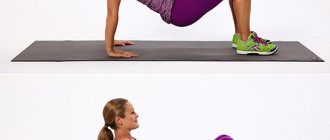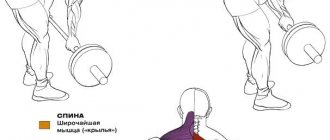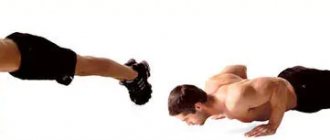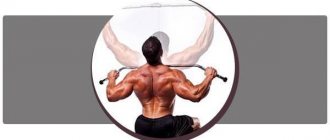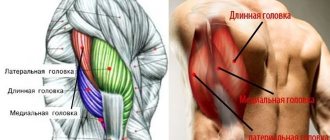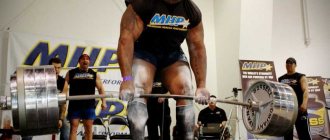Muscles involved
Not only the triceps are included in the work, although the main emphasis is on it. The triceps muscle (all 3 heads) is used as a holder. Movement is provided by the pectoral and anterior deltoid muscles. The rear delts, leg muscles, abs and back are auxiliary.
The triceps brachii muscle is responsible for extending the arm at the elbow joint. The pectoralis major – “pushes” the elbows forward and also brings them together. The serratus anterior muscle is necessary for spreading the shoulder blades, and the trapezius muscle is necessary for raising and rotating the shoulder blades. The front delts allow you to move your arm forward and upward.
Errors
The first mistake was mentioned above - the wrong grip.
The second common mistake when performing bench presses with a narrow grip is the incorrect trajectory of movement. Many people lower the barbell too high on their chest, to the level of the middle or even the top of the pectoral muscles. With such an amplitude of movement, part of the load leaves the triceps and is distributed between the anterior bundles of deltoid muscles and pectoral muscles.
The bar should descend to the solar plexus area and rise straight up. In this case, the deltoids and pectorals will be excluded from work as much as possible.
Another mistake that many people make due to ignorance of the methods of using a particular exercise is the incorrect use of close-grip presses. some athletes try to use this exercise to work the inner parts of the pectoral muscles.
In accordance with the technique of performing the exercise, most of the load falls on the triceps. A small part remains on the pectoral muscles, which is not able to give any result. To work out the inner part of the pectoral muscles, you need to use information in the simulator or dumbbell flyes while lying down.
Bench press technique
The result depends not so much on the working weight and approaches, but on maintaining the correct barbell press technique. You can regularly do a minimum number of repetitions, but achieve better results than constantly overstraining your muscles. The athlete must feel which muscles are working, otherwise the exercise is most likely performed incorrectly. The most popular option is lying on a horizontal bench, which is worth disassembling.
Initial position
You need to lie down on the bench so that the bar is at eye level. The back remains perfectly straight; you should try to bring your shoulder blades together. The pelvis and head do not come off the bench, as do the legs from the floor. The whole body should be in good shape, you can tense your buttocks. Particular attention is paid to the placement of the feet on the floor: you need to rest on your heels or the entire foot to ensure a stable position. This depends on the flexibility of the ankle joints, but you can’t focus on your toes! The bar must be held with a closed grip, pressing your fingers tightly against the projectile.
The width of the arms is the main point of concern for beginner athletes who perform barbell presses with a narrow grip on a bench. The palms should not be placed next to each other, but slightly narrower than shoulder width. The elbows are slightly bent and spread out to the sides. The most dangerous moment for the wrists is removing the barbell from the racks. They do this by exerting their triceps, gradually straightening their elbows. If the working weight is large, then a narrow bench press is performed with wrist supports made of hard material.
Next, the bar is placed just above the solar plexus, under the lower part of the chest. At the same time, inhale and smoothly lower the barbell until it touches your chest. It is necessary to perform movements slowly, avoiding the projectile hitting the body! The elbows are practically pressed against the body, but at the same time they are spread in different directions. You cannot bring them inside, otherwise injury will not be avoided.
Barbell bench press
After the bar has touched the chest, you should slowly squeeze it up. At the same moment, a deep breath is taken; it is not necessary to stop the projectile on the chest. As a rule, it is at this moment that a contraction of the medial fascicle of the triceps and other muscles of the chest is felt. Having squeezed the bar to its maximum point, it is recommended to pause for 1-2 seconds and then lower the bar. You need to work along one trajectory, without tilting the bar forward or backward.
It is acceptable to perform the bench press with a narrow grip on an incline bench. The exercise is technically difficult, so amateurs rarely resort to it. It is necessary to clearly feel the muscle contractions, but it is possible to work the “collar” - this is the middle of the upper chest. The barbell is placed not on the chest, but on the collarbones. The lifting of the barbell upward is carried out slowly; the athlete needs to pause for a few seconds so that the necessary muscles contract.
Close grip bench press
Main working muscles
:
Triceps, deltoids, pectoral muscles.
Short description:
Lying on your back, grab the bar with a shoulder-width grip, lower the bar to your chest, then lift it up again.
Introduction
This exercise is very similar to a regular bench press. The fundamental difference lies in the width of the grip and the trajectory of the barbell. The Bench Press chapter should be studied in conjunction with this Close Grip Bench Press chapter.
Preparation and starting position
In gyms, this exercise is traditionally done with such a narrow grip that the hands touch or almost touch each other. This technique guarantees that you will have serious joint problems in the near future. It is much safer to do this exercise with such a narrow grip, in which the hands are actually not so close to each other. It is enough to reduce your grip width by only 12.5 cm compared to a regular bench press. Depending on chest circumference and arm length, the average grip width for men is approximately 40.5 cm, for women - approximately 30.5 cm. Find a grip width that is comfortable for you. If in doubt, it is better to go wider rather than narrower. As in a regular bench press, in this exercise your forearms should also be strictly vertical - both when viewed from the front and from the side.
You need to lie on the bench in the same position as in a regular bench press: place your feet on the stand and do not grab the bar with an open grip.
Performance
Grasp the bar with your hands and have an assistant help you remove the bar from the racks. Keeping your arms straight, move the barbell to the starting position above your lower chest and pause briefly. In each repetition, lowering the bar down, the elbows must be moved slightly towards the torso. This will help you keep your elbows directly under your wrists.
Remember that the position of the joints relative to each other is very important. The bar should touch your chest at or just below your lower pectoral muscles.
The trajectory of the barbell here will be slightly different from a regular bench press. In a close-grip bench press, the bar should be pressed vertically up and down vertically.
Instead of lifting the barbell from the rack and then returning it to its place, you can do close-grip presses from the clamps of a power rack. As with the regular bench press, you can choose between the touch press and the rack bottom press.
Additional Tips
The close-grip bench press, compared to the standard bench press, can cause excessive shoulder extension, especially in lanky individuals with long limbs. If the close-grip bench press is causing you shoulder pain—even when you do it with the technique described in this book—then you will need to make some changes to the movement. Do the exercise in a power rack, and set the limiters at such a height as to reduce the range of motion by several centimeters. Thus, your shoulder joints will extend less, and the exercise will become safer for you.
Comparison of grip width in a regular bench press (left) and a safety close grip bench press (right). The difference in grip width is only 12.5 cm. In both versions of the press, the bar is located in line with the pectoral muscles. Your elbows should be directly under your wrists.
An overly narrow grip is very dangerous. It injures elbows and wrists. As you can see, in this picture the elbows are far from being under the wrists.
In the close grip bench press, muscle failure occurs rapidly. If you're training alone, be extremely careful and train on equipment that will support the weight of the barbell if you get crushed. Stop the set immediately as soon as you feel your elbows begin to “drift” to the sides, despite the fact that you are making every effort to keep them in the correct position.
Insurance
See the Bench Press chapter. In this exercise, the belay recommendations are practically no different from the regular bench press. But due to the fact that failure occurs more quickly in the close-grip bench press, your assistant must have a good reaction and be extremely attentive. He should be ready to come to your aid at any second - as soon as the upward movement of the bar stops or as soon as your elbows begin to “move apart” to the sides.
What not to do during exercise
Inexperienced athletes have the habit of actively moving their elbows to the sides while lowering the apparatus. This always leads to pain and even serious injuries to the shoulder or elbow joint. You need to make sure that your hands are almost tightly pressed to your ribs. Another mistake is an open grip. Sometimes it really helps to feel the contraction of the pectoral muscles, but there is a huge risk of accidentally dropping the barbell on yourself while lying down, which will lead to a disastrous result.
You can't neglect warming up before starting a workout. No matter how good the physical preparation, an athlete can always get injured without warm-up approaches.
Alexander Shestov
TRX Certified Trainer
Ask a Question
Gymnastics will help not only warm up your joints and ligaments, but also psychologically prepare you for the triceps barbell press.
It is unacceptable to lift your buttocks or head off the bench; they should be pressed tightly during the entire approach. Otherwise, the load on the intervertebral discs increases. It is important to properly distribute your strength during training, because the bench press is not the only thing that should be in the program. It is recommended to perform it no more than 2-3 times a week. The rest of the time you can work out other muscle groups.
Analysis of the exercise
Anatomy of an exercise: which muscles work?
The close-grip barbell row to the chin is a variation of the exercise that, in addition to the deltoids, allows you to increase the participation of the trapezius and biceps in the pulling movement. The use of “narrow” vertical traction in training allows you to distinguish between the trapezius and deltoids, and to draw the shape and relief of the target muscles.
Essentially, the work in terms of muscle groups looks similar to the “wide” deadlift with only a slight change in training emphasis:
Preparing for the exercise
Perform warm-up exercises for the target muscles - the trapezius, for example, several sets of shrugs with small dumbbells will be enough to prepare them for work. Additionally, it is recommended to actively stretch the deltas using the following exercises: pull your elbow to the opposite shoulder or lean your outstretched arm against the wall and turn your body in the direction opposite to the support.
After the “preparatory” block, proceed to a specialized warm-up - perform several preliminary sets of vertical rows with minimal weights.
Proper execution
Errors
Performance Recommendations
Inclusion in the program
Close-grip barbell rows have the best training effect when combined with exercises that more specifically stimulate the trapezius muscles, such as shrugs. Perform 2-5 sets of deadlifts for 10-12 reps after the basic block.
The weight of the apparatus in this variation of the exercise is significantly limited by the biomechanics of movement (it is determined by the close relative position of the hands). Accordingly, the higher the weight, the greater the requirements for the “cleanliness” of the equipment and the higher the risk of injury to the shoulder joints. As a conclusion: you shouldn’t overload the barbell with plates - stick to the measure and use weights that allow you to complete the approach while maintaining the correct form of movement.
Contraindications
Since during deadlifts the main movement occurs in the shoulder joint, any injury to it can become a limitation to performing this exercise. In the “narrow” traction version, this recommendation is especially relevant due to the expanded (and, therefore, potentially traumatic) range of motion.
Lifting the barbell to the chin with a narrow grip also places a serious load on the wrist joint at the top of the movement, so performing the exercise with a “basic” apparatus is not recommended for athletes with injuries in this area. Alternatively, you can practice dumbbell rows to reduce stress on your wrists.
How to train girls correctly
Women, like men, require a close-grip bench press. It will help get rid of weakened triceps, and most importantly, loose skin on the arms. To prevent pain after exercise, you must follow the following rules:
- use a small working weight or an empty curved bar;
- calculate the load so that calories are burned, but the muscles do not increase significantly in size;
- do not do more than two sets of 8 repetitions with a narrow grip for girls, rest time is 1-2 minutes;
- do not exercise without warming up;
- train under the supervision of a trainer if you have no idea about the technique;
- perform bench press with a narrow grip no more than 3 times a week;
- Monitor your health and, if necessary, reduce the number of approaches.
Bench pressing with a narrow grip is not always beneficial. If an athlete trains through pain or violates technique, then a positive result from the training may not be expected. It’s better to use the services of a trainer the first time to hone your technique to perfection.
Ask your question to the coach:
Grip
The grip should be shoulder-width apart or slightly narrower. Many beginner athletes make the mistake of using a very narrow grip to perform the press. Not only does this not improve the quality of the exercise, but it also creates additional breaking stress on the wrists, especially at the bottom of the movement.
Such a grip can lead to injury. Also, if you constantly perform the exercise with a very narrow grip, your hands will gradually begin to hurt without any load. This way you will create a problem for yourself for the rest of your life.

